Yoga Tourism: Partnering with NGOs for Social Growth in Cambodia
VerifiedAdded on 2023/06/13
|24
|5403
|487
Report
AI Summary
This report investigates the potential of yoga tourism as a catalyst for social and economic development in Cambodia, focusing on partnerships between yoga centers and local NGOs. It examines how yoga retreats can contribute to the rehabilitation of disadvantaged individuals and create value for international tourists through carefully designed marketing mixes. The research explores service attributes, pricing strategies, and promotional campaigns that can attract tourists while benefiting local communities. It also considers the role of social enterprises in creating employment opportunities and fostering economic growth, ultimately suggesting that a well-planned yoga tourism sector can drive sustainable development and improve livelihoods in Cambodia. Desklib provides a platform for students to access past papers and solved assignments.
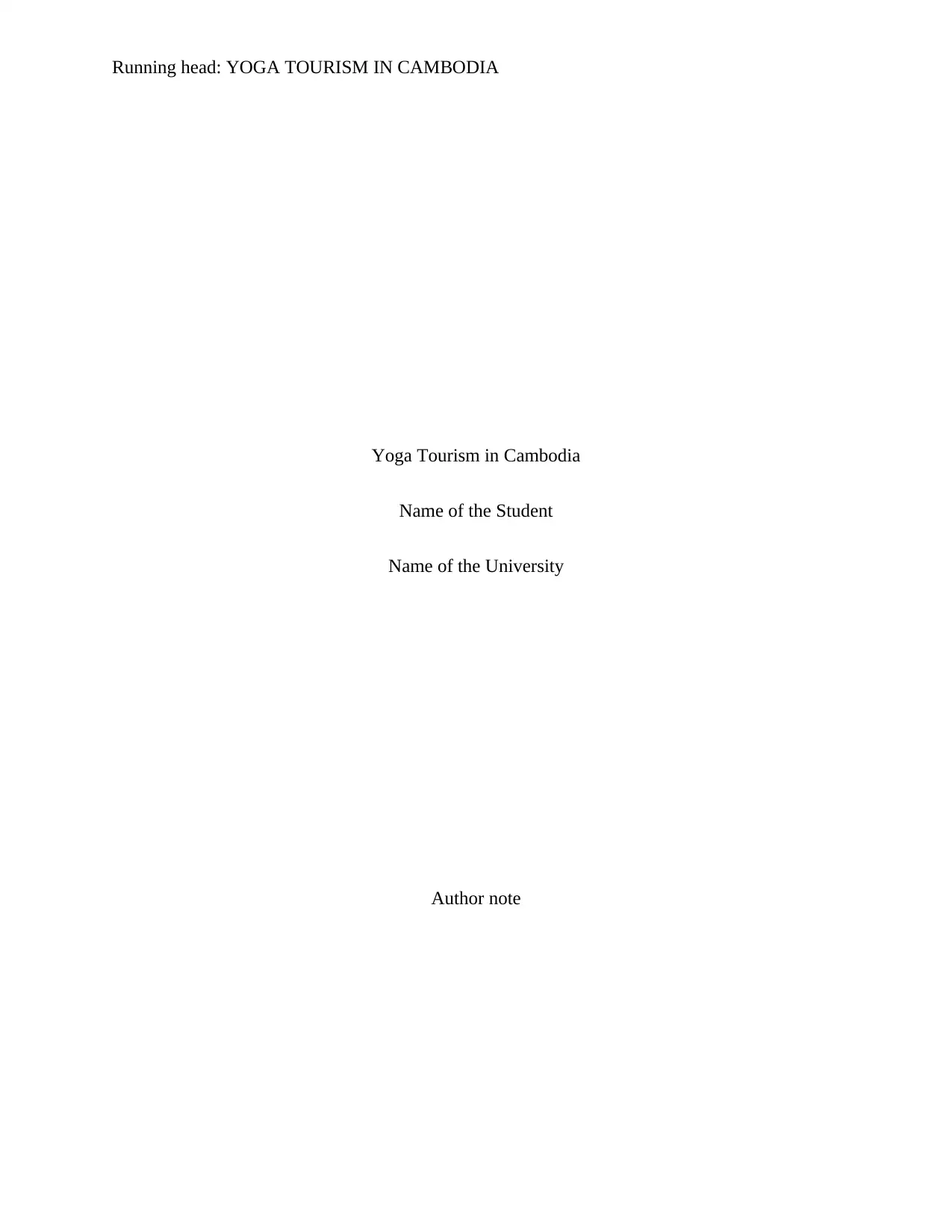
Running head: YOGA TOURISM IN CAMBODIA
Yoga Tourism in Cambodia
Name of the Student
Name of the University
Author note
Yoga Tourism in Cambodia
Name of the Student
Name of the University
Author note
Paraphrase This Document
Need a fresh take? Get an instant paraphrase of this document with our AI Paraphraser
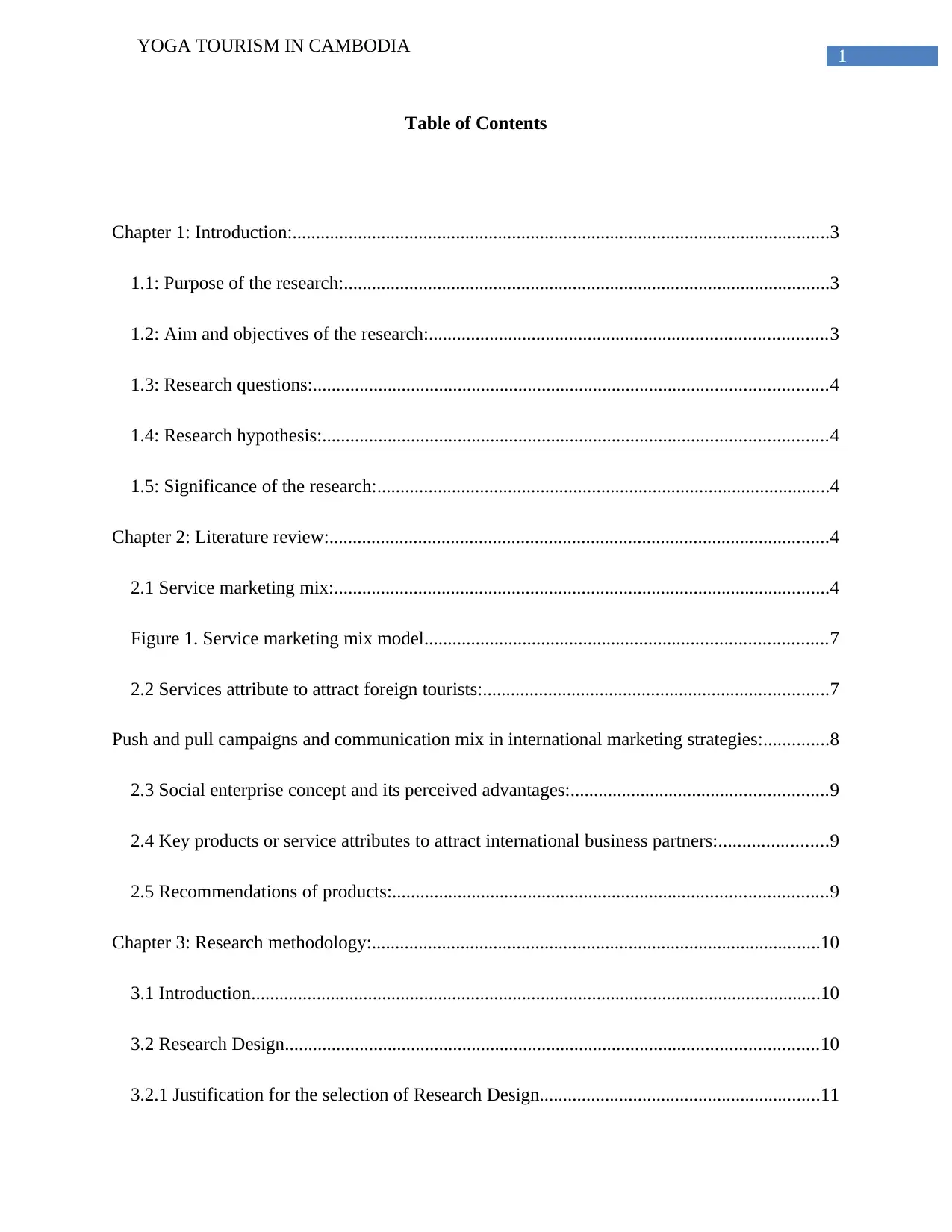
1
YOGA TOURISM IN CAMBODIA
Table of Contents
Chapter 1: Introduction:...................................................................................................................3
1.1: Purpose of the research:........................................................................................................3
1.2: Aim and objectives of the research:.....................................................................................3
1.3: Research questions:..............................................................................................................4
1.4: Research hypothesis:............................................................................................................4
1.5: Significance of the research:.................................................................................................4
Chapter 2: Literature review:...........................................................................................................4
2.1 Service marketing mix:..........................................................................................................4
Figure 1. Service marketing mix model......................................................................................7
2.2 Services attribute to attract foreign tourists:..........................................................................7
Push and pull campaigns and communication mix in international marketing strategies:..............8
2.3 Social enterprise concept and its perceived advantages:.......................................................9
2.4 Key products or service attributes to attract international business partners:.......................9
2.5 Recommendations of products:.............................................................................................9
Chapter 3: Research methodology:................................................................................................10
3.1 Introduction..........................................................................................................................10
3.2 Research Design..................................................................................................................10
3.2.1 Justification for the selection of Research Design............................................................11
YOGA TOURISM IN CAMBODIA
Table of Contents
Chapter 1: Introduction:...................................................................................................................3
1.1: Purpose of the research:........................................................................................................3
1.2: Aim and objectives of the research:.....................................................................................3
1.3: Research questions:..............................................................................................................4
1.4: Research hypothesis:............................................................................................................4
1.5: Significance of the research:.................................................................................................4
Chapter 2: Literature review:...........................................................................................................4
2.1 Service marketing mix:..........................................................................................................4
Figure 1. Service marketing mix model......................................................................................7
2.2 Services attribute to attract foreign tourists:..........................................................................7
Push and pull campaigns and communication mix in international marketing strategies:..............8
2.3 Social enterprise concept and its perceived advantages:.......................................................9
2.4 Key products or service attributes to attract international business partners:.......................9
2.5 Recommendations of products:.............................................................................................9
Chapter 3: Research methodology:................................................................................................10
3.1 Introduction..........................................................................................................................10
3.2 Research Design..................................................................................................................10
3.2.1 Justification for the selection of Research Design............................................................11
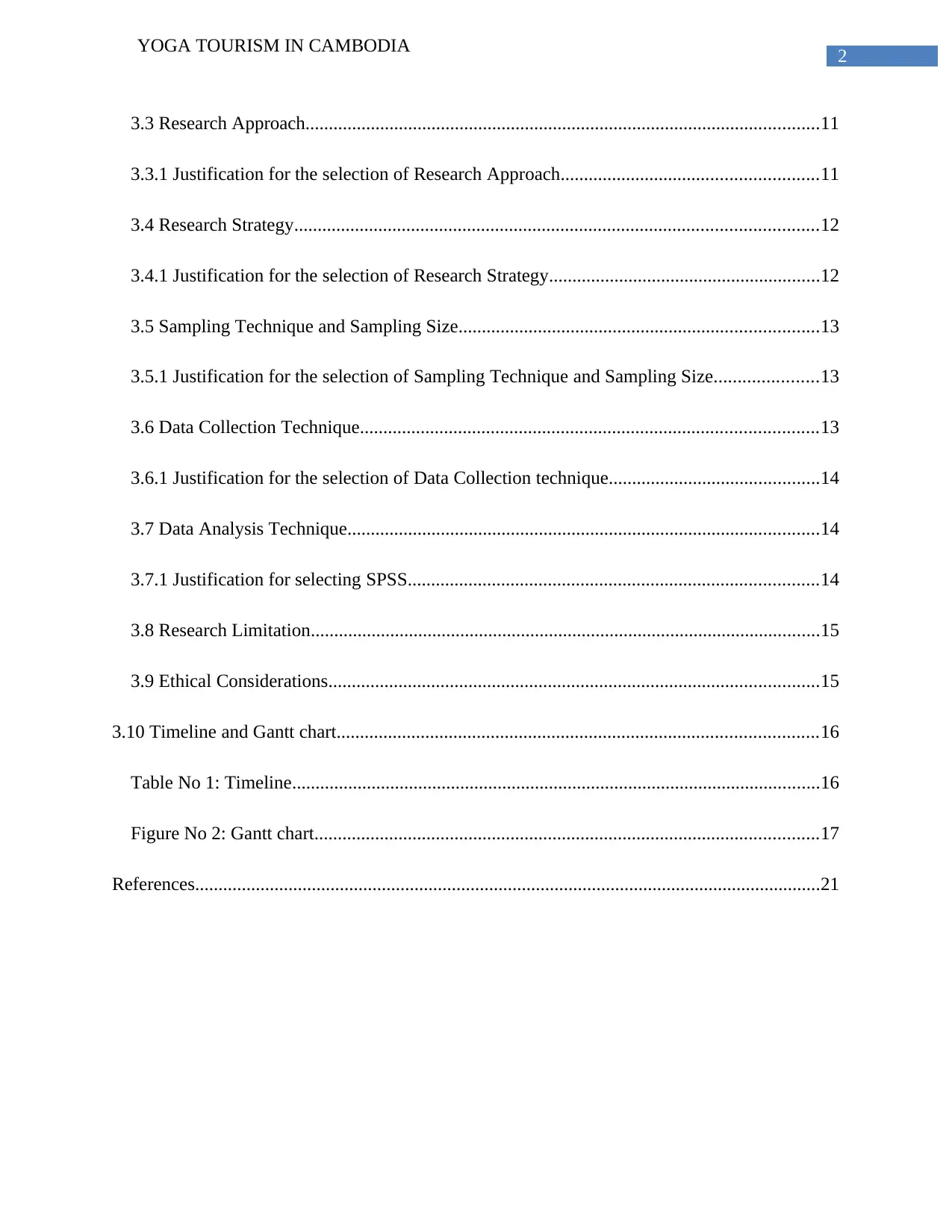
2
YOGA TOURISM IN CAMBODIA
3.3 Research Approach..............................................................................................................11
3.3.1 Justification for the selection of Research Approach.......................................................11
3.4 Research Strategy................................................................................................................12
3.4.1 Justification for the selection of Research Strategy..........................................................12
3.5 Sampling Technique and Sampling Size.............................................................................13
3.5.1 Justification for the selection of Sampling Technique and Sampling Size......................13
3.6 Data Collection Technique..................................................................................................13
3.6.1 Justification for the selection of Data Collection technique.............................................14
3.7 Data Analysis Technique.....................................................................................................14
3.7.1 Justification for selecting SPSS........................................................................................14
3.8 Research Limitation.............................................................................................................15
3.9 Ethical Considerations.........................................................................................................15
3.10 Timeline and Gantt chart.......................................................................................................16
Table No 1: Timeline.................................................................................................................16
Figure No 2: Gantt chart............................................................................................................17
References......................................................................................................................................21
YOGA TOURISM IN CAMBODIA
3.3 Research Approach..............................................................................................................11
3.3.1 Justification for the selection of Research Approach.......................................................11
3.4 Research Strategy................................................................................................................12
3.4.1 Justification for the selection of Research Strategy..........................................................12
3.5 Sampling Technique and Sampling Size.............................................................................13
3.5.1 Justification for the selection of Sampling Technique and Sampling Size......................13
3.6 Data Collection Technique..................................................................................................13
3.6.1 Justification for the selection of Data Collection technique.............................................14
3.7 Data Analysis Technique.....................................................................................................14
3.7.1 Justification for selecting SPSS........................................................................................14
3.8 Research Limitation.............................................................................................................15
3.9 Ethical Considerations.........................................................................................................15
3.10 Timeline and Gantt chart.......................................................................................................16
Table No 1: Timeline.................................................................................................................16
Figure No 2: Gantt chart............................................................................................................17
References......................................................................................................................................21
⊘ This is a preview!⊘
Do you want full access?
Subscribe today to unlock all pages.

Trusted by 1+ million students worldwide
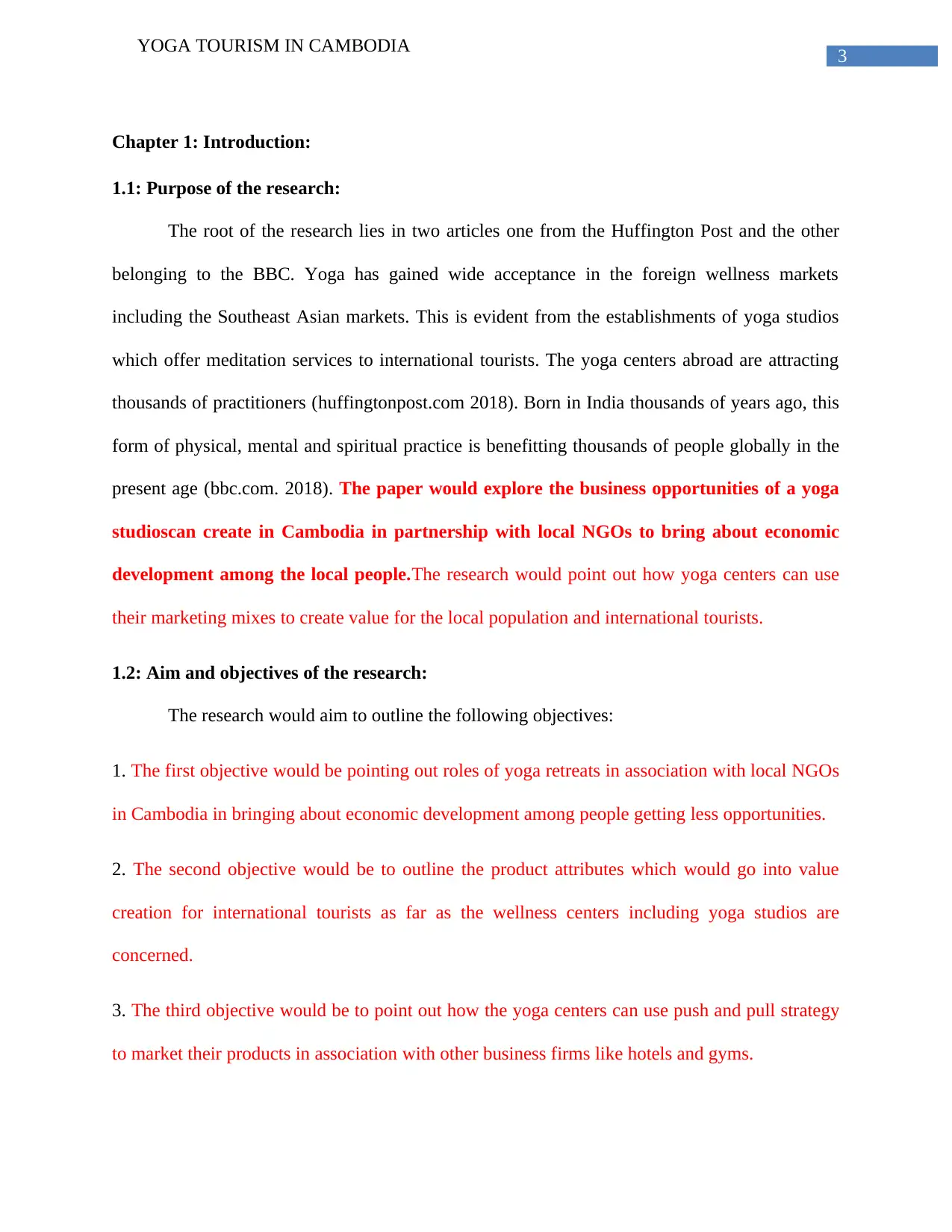
3
YOGA TOURISM IN CAMBODIA
Chapter 1: Introduction:
1.1: Purpose of the research:
The root of the research lies in two articles one from the Huffington Post and the other
belonging to the BBC. Yoga has gained wide acceptance in the foreign wellness markets
including the Southeast Asian markets. This is evident from the establishments of yoga studios
which offer meditation services to international tourists. The yoga centers abroad are attracting
thousands of practitioners (huffingtonpost.com 2018). Born in India thousands of years ago, this
form of physical, mental and spiritual practice is benefitting thousands of people globally in the
present age (bbc.com. 2018). The paper would explore the business opportunities of a yoga
studioscan create in Cambodia in partnership with local NGOs to bring about economic
development among the local people.The research would point out how yoga centers can use
their marketing mixes to create value for the local population and international tourists.
1.2: Aim and objectives of the research:
The research would aim to outline the following objectives:
1. The first objective would be pointing out roles of yoga retreats in association with local NGOs
in Cambodia in bringing about economic development among people getting less opportunities.
2. The second objective would be to outline the product attributes which would go into value
creation for international tourists as far as the wellness centers including yoga studios are
concerned.
3. The third objective would be to point out how the yoga centers can use push and pull strategy
to market their products in association with other business firms like hotels and gyms.
YOGA TOURISM IN CAMBODIA
Chapter 1: Introduction:
1.1: Purpose of the research:
The root of the research lies in two articles one from the Huffington Post and the other
belonging to the BBC. Yoga has gained wide acceptance in the foreign wellness markets
including the Southeast Asian markets. This is evident from the establishments of yoga studios
which offer meditation services to international tourists. The yoga centers abroad are attracting
thousands of practitioners (huffingtonpost.com 2018). Born in India thousands of years ago, this
form of physical, mental and spiritual practice is benefitting thousands of people globally in the
present age (bbc.com. 2018). The paper would explore the business opportunities of a yoga
studioscan create in Cambodia in partnership with local NGOs to bring about economic
development among the local people.The research would point out how yoga centers can use
their marketing mixes to create value for the local population and international tourists.
1.2: Aim and objectives of the research:
The research would aim to outline the following objectives:
1. The first objective would be pointing out roles of yoga retreats in association with local NGOs
in Cambodia in bringing about economic development among people getting less opportunities.
2. The second objective would be to outline the product attributes which would go into value
creation for international tourists as far as the wellness centers including yoga studios are
concerned.
3. The third objective would be to point out how the yoga centers can use push and pull strategy
to market their products in association with other business firms like hotels and gyms.
Paraphrase This Document
Need a fresh take? Get an instant paraphrase of this document with our AI Paraphraser
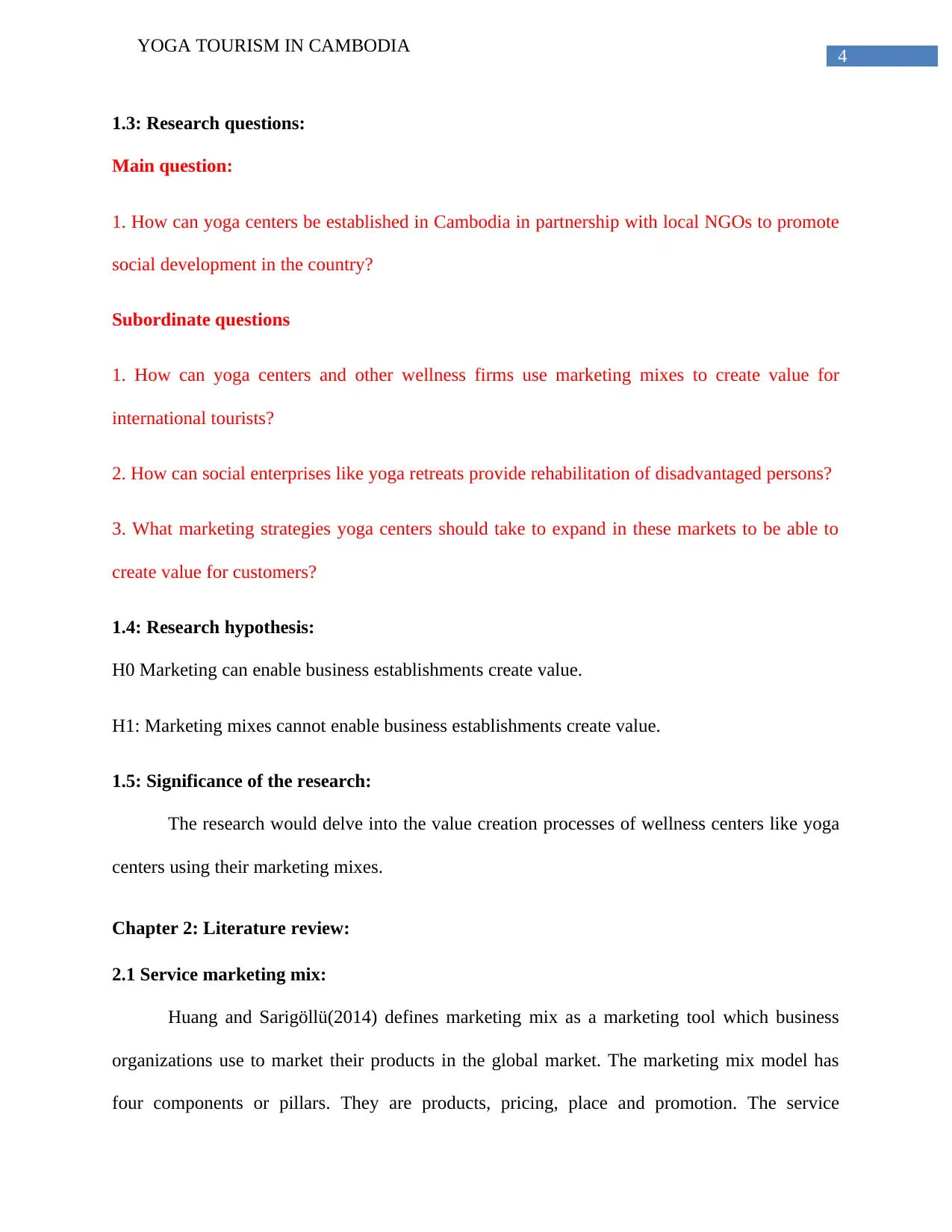
4
YOGA TOURISM IN CAMBODIA
1.3: Research questions:
Main question:
1. How can yoga centers be established in Cambodia in partnership with local NGOs to promote
social development in the country?
Subordinate questions
1. How can yoga centers and other wellness firms use marketing mixes to create value for
international tourists?
2. How can social enterprises like yoga retreats provide rehabilitation of disadvantaged persons?
3. What marketing strategies yoga centers should take to expand in these markets to be able to
create value for customers?
1.4: Research hypothesis:
H0 Marketing can enable business establishments create value.
H1: Marketing mixes cannot enable business establishments create value.
1.5: Significance of the research:
The research would delve into the value creation processes of wellness centers like yoga
centers using their marketing mixes.
Chapter 2: Literature review:
2.1 Service marketing mix:
Huang and Sarigöllü(2014) defines marketing mix as a marketing tool which business
organizations use to market their products in the global market. The marketing mix model has
four components or pillars. They are products, pricing, place and promotion. The service
YOGA TOURISM IN CAMBODIA
1.3: Research questions:
Main question:
1. How can yoga centers be established in Cambodia in partnership with local NGOs to promote
social development in the country?
Subordinate questions
1. How can yoga centers and other wellness firms use marketing mixes to create value for
international tourists?
2. How can social enterprises like yoga retreats provide rehabilitation of disadvantaged persons?
3. What marketing strategies yoga centers should take to expand in these markets to be able to
create value for customers?
1.4: Research hypothesis:
H0 Marketing can enable business establishments create value.
H1: Marketing mixes cannot enable business establishments create value.
1.5: Significance of the research:
The research would delve into the value creation processes of wellness centers like yoga
centers using their marketing mixes.
Chapter 2: Literature review:
2.1 Service marketing mix:
Huang and Sarigöllü(2014) defines marketing mix as a marketing tool which business
organizations use to market their products in the global market. The marketing mix model has
four components or pillars. They are products, pricing, place and promotion. The service
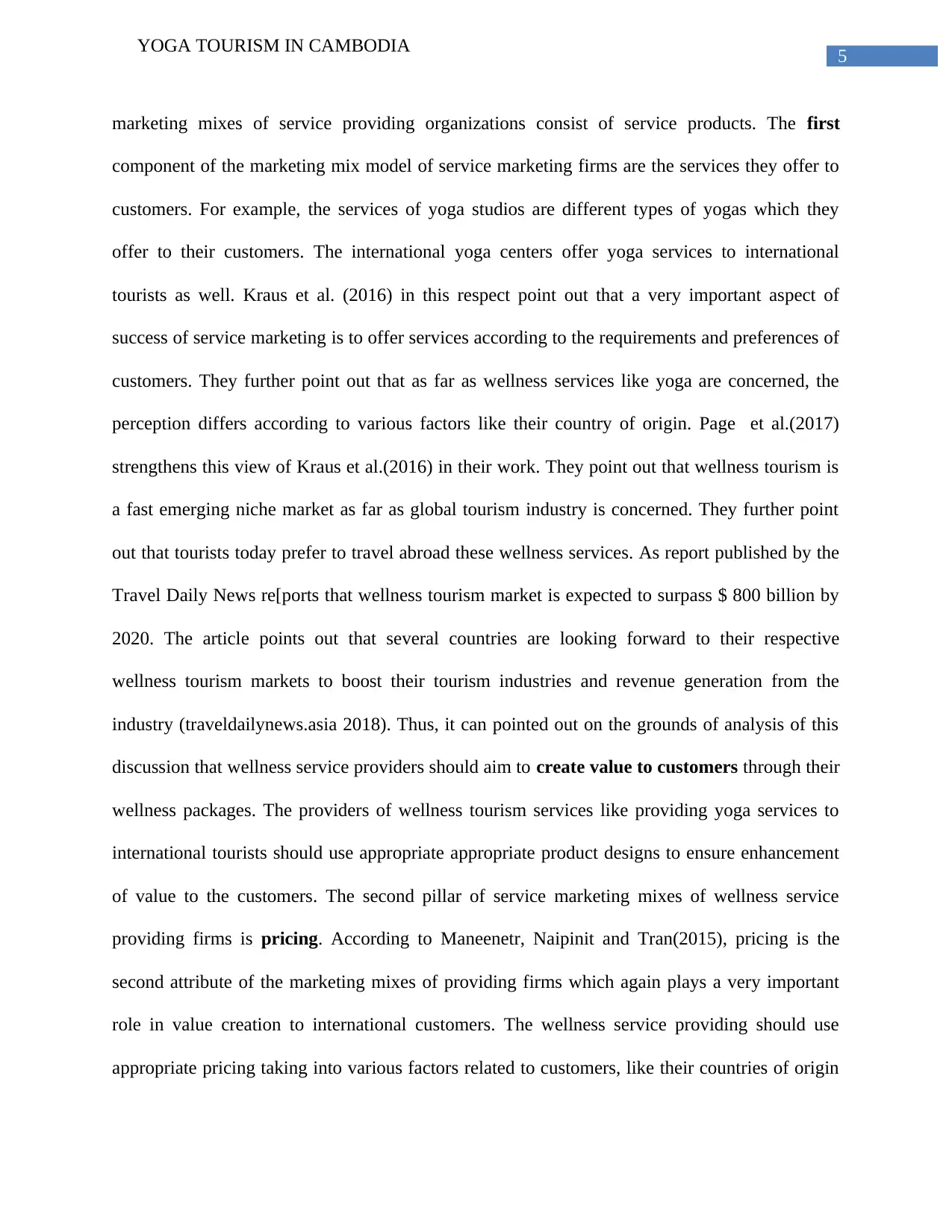
5
YOGA TOURISM IN CAMBODIA
marketing mixes of service providing organizations consist of service products. The first
component of the marketing mix model of service marketing firms are the services they offer to
customers. For example, the services of yoga studios are different types of yogas which they
offer to their customers. The international yoga centers offer yoga services to international
tourists as well. Kraus et al. (2016) in this respect point out that a very important aspect of
success of service marketing is to offer services according to the requirements and preferences of
customers. They further point out that as far as wellness services like yoga are concerned, the
perception differs according to various factors like their country of origin. Page et al.(2017)
strengthens this view of Kraus et al.(2016) in their work. They point out that wellness tourism is
a fast emerging niche market as far as global tourism industry is concerned. They further point
out that tourists today prefer to travel abroad these wellness services. As report published by the
Travel Daily News re[ports that wellness tourism market is expected to surpass $ 800 billion by
2020. The article points out that several countries are looking forward to their respective
wellness tourism markets to boost their tourism industries and revenue generation from the
industry (traveldailynews.asia 2018). Thus, it can pointed out on the grounds of analysis of this
discussion that wellness service providers should aim to create value to customers through their
wellness packages. The providers of wellness tourism services like providing yoga services to
international tourists should use appropriate appropriate product designs to ensure enhancement
of value to the customers. The second pillar of service marketing mixes of wellness service
providing firms is pricing. According to Maneenetr, Naipinit and Tran(2015), pricing is the
second attribute of the marketing mixes of providing firms which again plays a very important
role in value creation to international customers. The wellness service providing should use
appropriate pricing taking into various factors related to customers, like their countries of origin
YOGA TOURISM IN CAMBODIA
marketing mixes of service providing organizations consist of service products. The first
component of the marketing mix model of service marketing firms are the services they offer to
customers. For example, the services of yoga studios are different types of yogas which they
offer to their customers. The international yoga centers offer yoga services to international
tourists as well. Kraus et al. (2016) in this respect point out that a very important aspect of
success of service marketing is to offer services according to the requirements and preferences of
customers. They further point out that as far as wellness services like yoga are concerned, the
perception differs according to various factors like their country of origin. Page et al.(2017)
strengthens this view of Kraus et al.(2016) in their work. They point out that wellness tourism is
a fast emerging niche market as far as global tourism industry is concerned. They further point
out that tourists today prefer to travel abroad these wellness services. As report published by the
Travel Daily News re[ports that wellness tourism market is expected to surpass $ 800 billion by
2020. The article points out that several countries are looking forward to their respective
wellness tourism markets to boost their tourism industries and revenue generation from the
industry (traveldailynews.asia 2018). Thus, it can pointed out on the grounds of analysis of this
discussion that wellness service providers should aim to create value to customers through their
wellness packages. The providers of wellness tourism services like providing yoga services to
international tourists should use appropriate appropriate product designs to ensure enhancement
of value to the customers. The second pillar of service marketing mixes of wellness service
providing firms is pricing. According to Maneenetr, Naipinit and Tran(2015), pricing is the
second attribute of the marketing mixes of providing firms which again plays a very important
role in value creation to international customers. The wellness service providing should use
appropriate pricing taking into various factors related to customers, like their countries of origin
⊘ This is a preview!⊘
Do you want full access?
Subscribe today to unlock all pages.

Trusted by 1+ million students worldwide
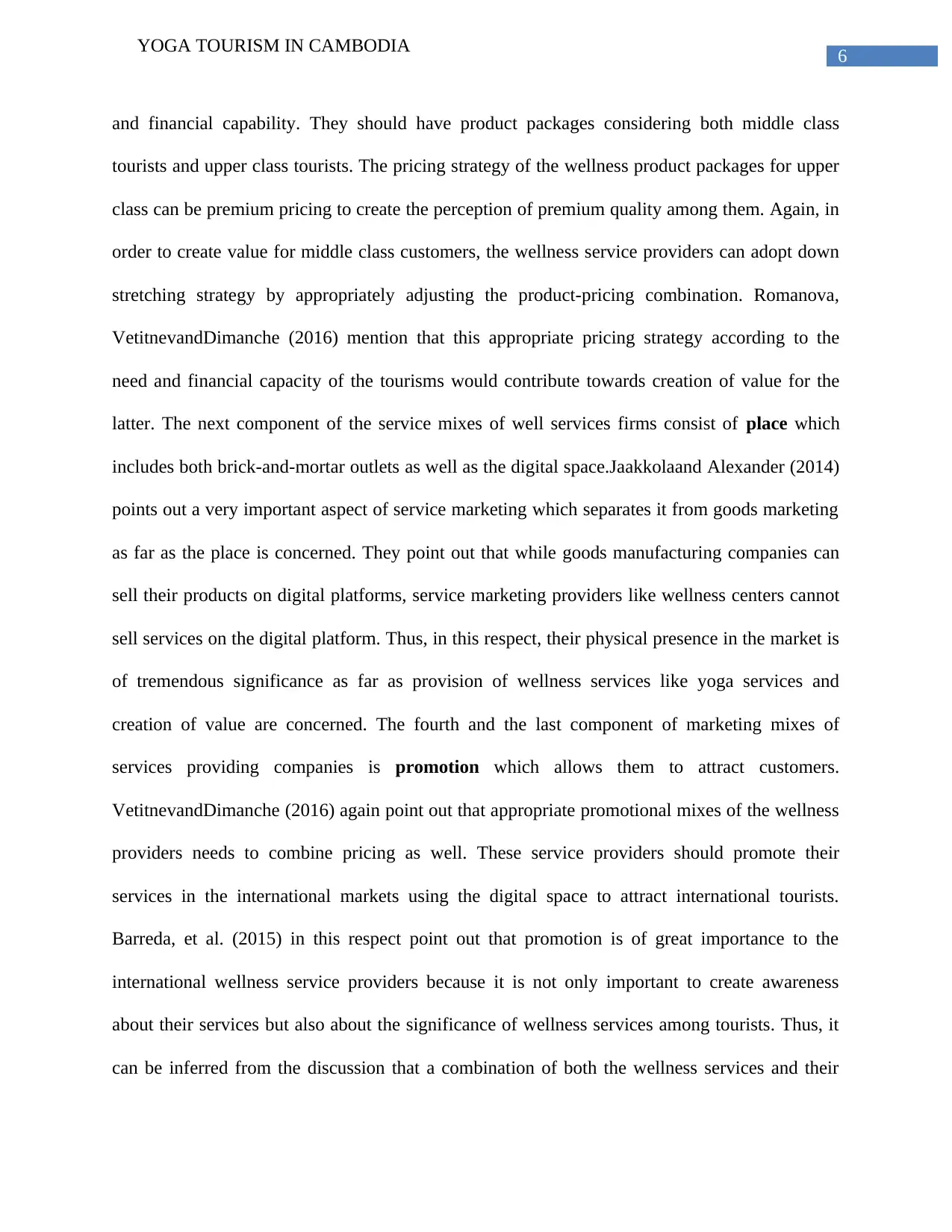
6
YOGA TOURISM IN CAMBODIA
and financial capability. They should have product packages considering both middle class
tourists and upper class tourists. The pricing strategy of the wellness product packages for upper
class can be premium pricing to create the perception of premium quality among them. Again, in
order to create value for middle class customers, the wellness service providers can adopt down
stretching strategy by appropriately adjusting the product-pricing combination. Romanova,
VetitnevandDimanche (2016) mention that this appropriate pricing strategy according to the
need and financial capacity of the tourisms would contribute towards creation of value for the
latter. The next component of the service mixes of well services firms consist of place which
includes both brick-and-mortar outlets as well as the digital space.Jaakkolaand Alexander (2014)
points out a very important aspect of service marketing which separates it from goods marketing
as far as the place is concerned. They point out that while goods manufacturing companies can
sell their products on digital platforms, service marketing providers like wellness centers cannot
sell services on the digital platform. Thus, in this respect, their physical presence in the market is
of tremendous significance as far as provision of wellness services like yoga services and
creation of value are concerned. The fourth and the last component of marketing mixes of
services providing companies is promotion which allows them to attract customers.
VetitnevandDimanche (2016) again point out that appropriate promotional mixes of the wellness
providers needs to combine pricing as well. These service providers should promote their
services in the international markets using the digital space to attract international tourists.
Barreda, et al. (2015) in this respect point out that promotion is of great importance to the
international wellness service providers because it is not only important to create awareness
about their services but also about the significance of wellness services among tourists. Thus, it
can be inferred from the discussion that a combination of both the wellness services and theirProduct(services)Pricing(differenttypesofpricesaspertheirservices)Place(outletsanddigitalplatforms)Promotion(advertisements,discounts,offers,digitalpromotion,audiovisualpromotionsandvsualpromotions)
YOGA TOURISM IN CAMBODIA
and financial capability. They should have product packages considering both middle class
tourists and upper class tourists. The pricing strategy of the wellness product packages for upper
class can be premium pricing to create the perception of premium quality among them. Again, in
order to create value for middle class customers, the wellness service providers can adopt down
stretching strategy by appropriately adjusting the product-pricing combination. Romanova,
VetitnevandDimanche (2016) mention that this appropriate pricing strategy according to the
need and financial capacity of the tourisms would contribute towards creation of value for the
latter. The next component of the service mixes of well services firms consist of place which
includes both brick-and-mortar outlets as well as the digital space.Jaakkolaand Alexander (2014)
points out a very important aspect of service marketing which separates it from goods marketing
as far as the place is concerned. They point out that while goods manufacturing companies can
sell their products on digital platforms, service marketing providers like wellness centers cannot
sell services on the digital platform. Thus, in this respect, their physical presence in the market is
of tremendous significance as far as provision of wellness services like yoga services and
creation of value are concerned. The fourth and the last component of marketing mixes of
services providing companies is promotion which allows them to attract customers.
VetitnevandDimanche (2016) again point out that appropriate promotional mixes of the wellness
providers needs to combine pricing as well. These service providers should promote their
services in the international markets using the digital space to attract international tourists.
Barreda, et al. (2015) in this respect point out that promotion is of great importance to the
international wellness service providers because it is not only important to create awareness
about their services but also about the significance of wellness services among tourists. Thus, it
can be inferred from the discussion that a combination of both the wellness services and theirProduct(services)Pricing(differenttypesofpricesaspertheirservices)Place(outletsanddigitalplatforms)Promotion(advertisements,discounts,offers,digitalpromotion,audiovisualpromotionsandvsualpromotions)
Paraphrase This Document
Need a fresh take? Get an instant paraphrase of this document with our AI Paraphraser
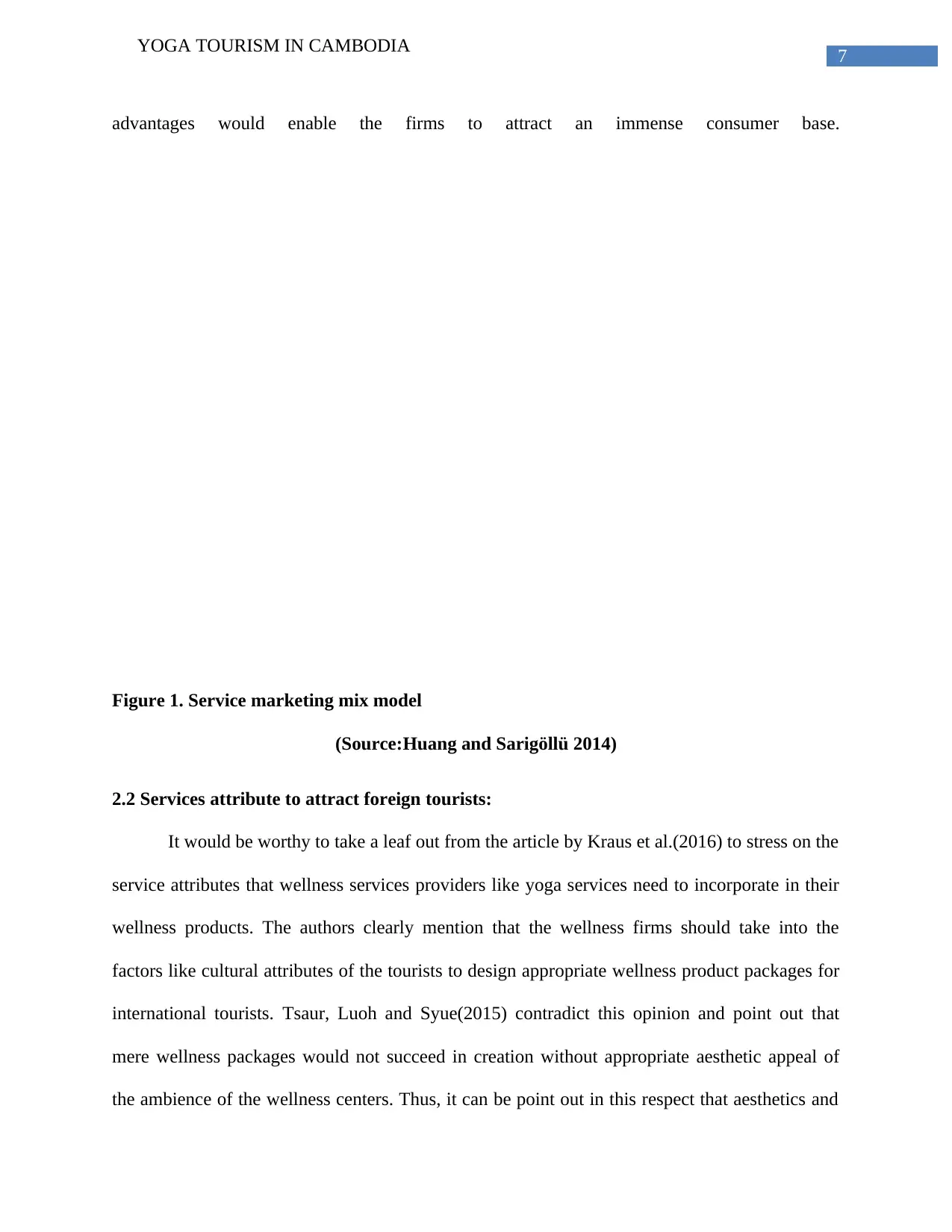
7
YOGA TOURISM IN CAMBODIA
advantages would enable the firms to attract an immense consumer base.
Figure 1. Service marketing mix model
(Source:Huang and Sarigöllü 2014)
2.2 Services attribute to attract foreign tourists:
It would be worthy to take a leaf out from the article by Kraus et al.(2016) to stress on the
service attributes that wellness services providers like yoga services need to incorporate in their
wellness products. The authors clearly mention that the wellness firms should take into the
factors like cultural attributes of the tourists to design appropriate wellness product packages for
international tourists. Tsaur, Luoh and Syue(2015) contradict this opinion and point out that
mere wellness packages would not succeed in creation without appropriate aesthetic appeal of
the ambience of the wellness centers. Thus, it can be point out in this respect that aesthetics and
YOGA TOURISM IN CAMBODIA
advantages would enable the firms to attract an immense consumer base.
Figure 1. Service marketing mix model
(Source:Huang and Sarigöllü 2014)
2.2 Services attribute to attract foreign tourists:
It would be worthy to take a leaf out from the article by Kraus et al.(2016) to stress on the
service attributes that wellness services providers like yoga services need to incorporate in their
wellness products. The authors clearly mention that the wellness firms should take into the
factors like cultural attributes of the tourists to design appropriate wellness product packages for
international tourists. Tsaur, Luoh and Syue(2015) contradict this opinion and point out that
mere wellness packages would not succeed in creation without appropriate aesthetic appeal of
the ambience of the wellness centers. Thus, it can be point out in this respect that aesthetics and
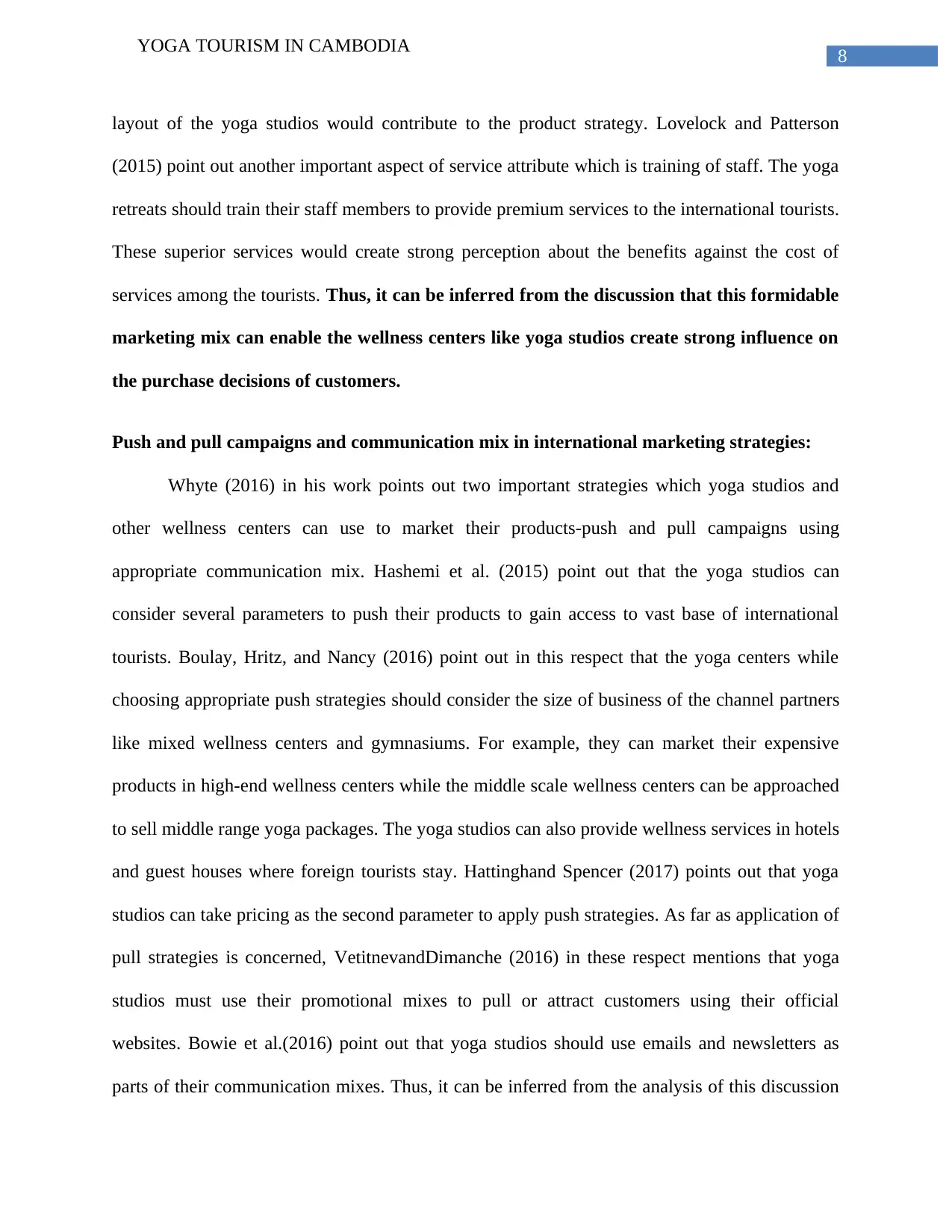
8
YOGA TOURISM IN CAMBODIA
layout of the yoga studios would contribute to the product strategy. Lovelock and Patterson
(2015) point out another important aspect of service attribute which is training of staff. The yoga
retreats should train their staff members to provide premium services to the international tourists.
These superior services would create strong perception about the benefits against the cost of
services among the tourists. Thus, it can be inferred from the discussion that this formidable
marketing mix can enable the wellness centers like yoga studios create strong influence on
the purchase decisions of customers.
Push and pull campaigns and communication mix in international marketing strategies:
Whyte (2016) in his work points out two important strategies which yoga studios and
other wellness centers can use to market their products-push and pull campaigns using
appropriate communication mix. Hashemi et al. (2015) point out that the yoga studios can
consider several parameters to push their products to gain access to vast base of international
tourists. Boulay, Hritz, and Nancy (2016) point out in this respect that the yoga centers while
choosing appropriate push strategies should consider the size of business of the channel partners
like mixed wellness centers and gymnasiums. For example, they can market their expensive
products in high-end wellness centers while the middle scale wellness centers can be approached
to sell middle range yoga packages. The yoga studios can also provide wellness services in hotels
and guest houses where foreign tourists stay. Hattinghand Spencer (2017) points out that yoga
studios can take pricing as the second parameter to apply push strategies. As far as application of
pull strategies is concerned, VetitnevandDimanche (2016) in these respect mentions that yoga
studios must use their promotional mixes to pull or attract customers using their official
websites. Bowie et al.(2016) point out that yoga studios should use emails and newsletters as
parts of their communication mixes. Thus, it can be inferred from the analysis of this discussion
YOGA TOURISM IN CAMBODIA
layout of the yoga studios would contribute to the product strategy. Lovelock and Patterson
(2015) point out another important aspect of service attribute which is training of staff. The yoga
retreats should train their staff members to provide premium services to the international tourists.
These superior services would create strong perception about the benefits against the cost of
services among the tourists. Thus, it can be inferred from the discussion that this formidable
marketing mix can enable the wellness centers like yoga studios create strong influence on
the purchase decisions of customers.
Push and pull campaigns and communication mix in international marketing strategies:
Whyte (2016) in his work points out two important strategies which yoga studios and
other wellness centers can use to market their products-push and pull campaigns using
appropriate communication mix. Hashemi et al. (2015) point out that the yoga studios can
consider several parameters to push their products to gain access to vast base of international
tourists. Boulay, Hritz, and Nancy (2016) point out in this respect that the yoga centers while
choosing appropriate push strategies should consider the size of business of the channel partners
like mixed wellness centers and gymnasiums. For example, they can market their expensive
products in high-end wellness centers while the middle scale wellness centers can be approached
to sell middle range yoga packages. The yoga studios can also provide wellness services in hotels
and guest houses where foreign tourists stay. Hattinghand Spencer (2017) points out that yoga
studios can take pricing as the second parameter to apply push strategies. As far as application of
pull strategies is concerned, VetitnevandDimanche (2016) in these respect mentions that yoga
studios must use their promotional mixes to pull or attract customers using their official
websites. Bowie et al.(2016) point out that yoga studios should use emails and newsletters as
parts of their communication mixes. Thus, it can be inferred from the analysis of this discussion
⊘ This is a preview!⊘
Do you want full access?
Subscribe today to unlock all pages.

Trusted by 1+ million students worldwide
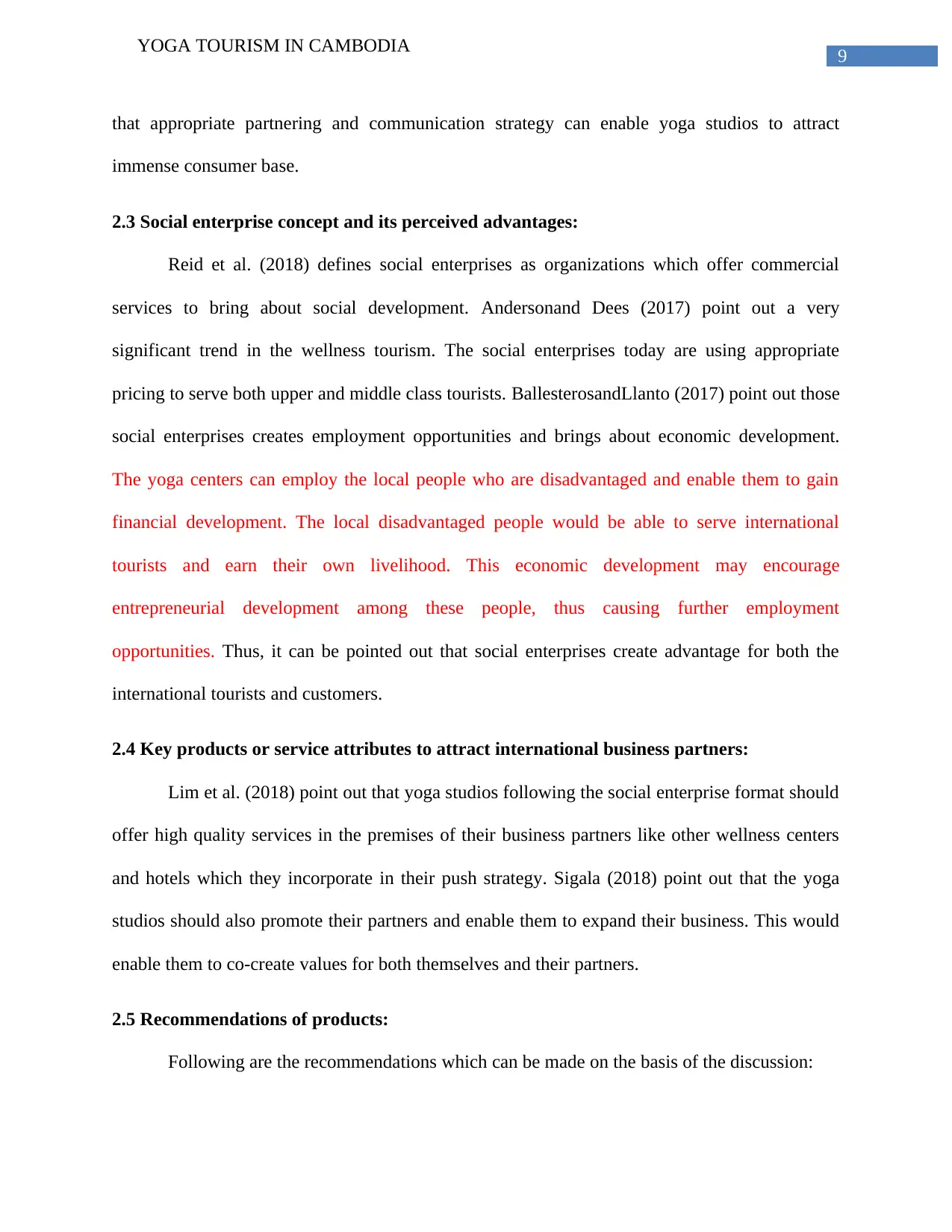
9
YOGA TOURISM IN CAMBODIA
that appropriate partnering and communication strategy can enable yoga studios to attract
immense consumer base.
2.3 Social enterprise concept and its perceived advantages:
Reid et al. (2018) defines social enterprises as organizations which offer commercial
services to bring about social development. Andersonand Dees (2017) point out a very
significant trend in the wellness tourism. The social enterprises today are using appropriate
pricing to serve both upper and middle class tourists. BallesterosandLlanto (2017) point out those
social enterprises creates employment opportunities and brings about economic development.
The yoga centers can employ the local people who are disadvantaged and enable them to gain
financial development. The local disadvantaged people would be able to serve international
tourists and earn their own livelihood. This economic development may encourage
entrepreneurial development among these people, thus causing further employment
opportunities. Thus, it can be pointed out that social enterprises create advantage for both the
international tourists and customers.
2.4 Key products or service attributes to attract international business partners:
Lim et al. (2018) point out that yoga studios following the social enterprise format should
offer high quality services in the premises of their business partners like other wellness centers
and hotels which they incorporate in their push strategy. Sigala (2018) point out that the yoga
studios should also promote their partners and enable them to expand their business. This would
enable them to co-create values for both themselves and their partners.
2.5 Recommendations of products:
Following are the recommendations which can be made on the basis of the discussion:
YOGA TOURISM IN CAMBODIA
that appropriate partnering and communication strategy can enable yoga studios to attract
immense consumer base.
2.3 Social enterprise concept and its perceived advantages:
Reid et al. (2018) defines social enterprises as organizations which offer commercial
services to bring about social development. Andersonand Dees (2017) point out a very
significant trend in the wellness tourism. The social enterprises today are using appropriate
pricing to serve both upper and middle class tourists. BallesterosandLlanto (2017) point out those
social enterprises creates employment opportunities and brings about economic development.
The yoga centers can employ the local people who are disadvantaged and enable them to gain
financial development. The local disadvantaged people would be able to serve international
tourists and earn their own livelihood. This economic development may encourage
entrepreneurial development among these people, thus causing further employment
opportunities. Thus, it can be pointed out that social enterprises create advantage for both the
international tourists and customers.
2.4 Key products or service attributes to attract international business partners:
Lim et al. (2018) point out that yoga studios following the social enterprise format should
offer high quality services in the premises of their business partners like other wellness centers
and hotels which they incorporate in their push strategy. Sigala (2018) point out that the yoga
studios should also promote their partners and enable them to expand their business. This would
enable them to co-create values for both themselves and their partners.
2.5 Recommendations of products:
Following are the recommendations which can be made on the basis of the discussion:
Paraphrase This Document
Need a fresh take? Get an instant paraphrase of this document with our AI Paraphraser
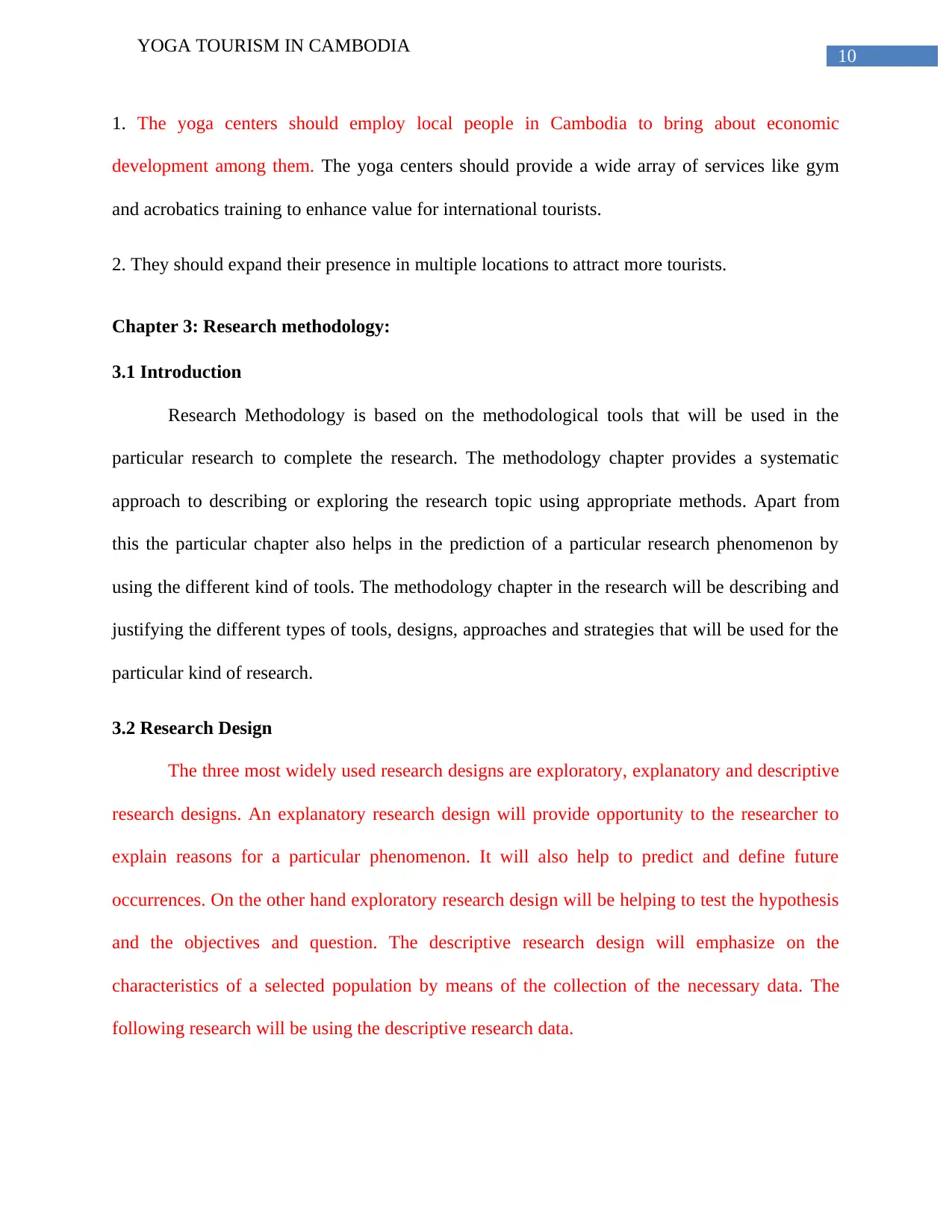
10
YOGA TOURISM IN CAMBODIA
1. The yoga centers should employ local people in Cambodia to bring about economic
development among them. The yoga centers should provide a wide array of services like gym
and acrobatics training to enhance value for international tourists.
2. They should expand their presence in multiple locations to attract more tourists.
Chapter 3: Research methodology:
3.1 Introduction
Research Methodology is based on the methodological tools that will be used in the
particular research to complete the research. The methodology chapter provides a systematic
approach to describing or exploring the research topic using appropriate methods. Apart from
this the particular chapter also helps in the prediction of a particular research phenomenon by
using the different kind of tools. The methodology chapter in the research will be describing and
justifying the different types of tools, designs, approaches and strategies that will be used for the
particular kind of research.
3.2 Research Design
The three most widely used research designs are exploratory, explanatory and descriptive
research designs. An explanatory research design will provide opportunity to the researcher to
explain reasons for a particular phenomenon. It will also help to predict and define future
occurrences. On the other hand exploratory research design will be helping to test the hypothesis
and the objectives and question. The descriptive research design will emphasize on the
characteristics of a selected population by means of the collection of the necessary data. The
following research will be using the descriptive research data.
YOGA TOURISM IN CAMBODIA
1. The yoga centers should employ local people in Cambodia to bring about economic
development among them. The yoga centers should provide a wide array of services like gym
and acrobatics training to enhance value for international tourists.
2. They should expand their presence in multiple locations to attract more tourists.
Chapter 3: Research methodology:
3.1 Introduction
Research Methodology is based on the methodological tools that will be used in the
particular research to complete the research. The methodology chapter provides a systematic
approach to describing or exploring the research topic using appropriate methods. Apart from
this the particular chapter also helps in the prediction of a particular research phenomenon by
using the different kind of tools. The methodology chapter in the research will be describing and
justifying the different types of tools, designs, approaches and strategies that will be used for the
particular kind of research.
3.2 Research Design
The three most widely used research designs are exploratory, explanatory and descriptive
research designs. An explanatory research design will provide opportunity to the researcher to
explain reasons for a particular phenomenon. It will also help to predict and define future
occurrences. On the other hand exploratory research design will be helping to test the hypothesis
and the objectives and question. The descriptive research design will emphasize on the
characteristics of a selected population by means of the collection of the necessary data. The
following research will be using the descriptive research data.
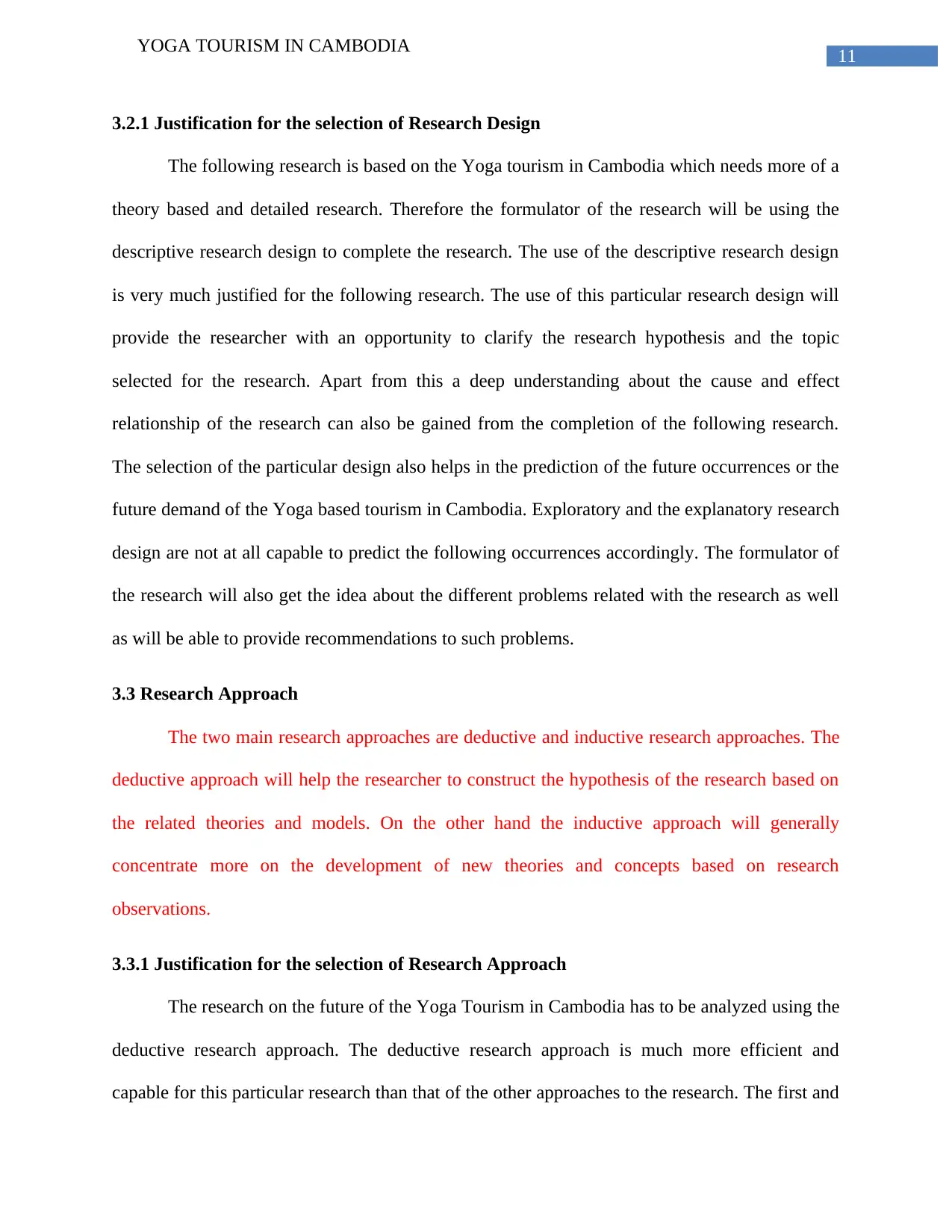
11
YOGA TOURISM IN CAMBODIA
3.2.1 Justification for the selection of Research Design
The following research is based on the Yoga tourism in Cambodia which needs more of a
theory based and detailed research. Therefore the formulator of the research will be using the
descriptive research design to complete the research. The use of the descriptive research design
is very much justified for the following research. The use of this particular research design will
provide the researcher with an opportunity to clarify the research hypothesis and the topic
selected for the research. Apart from this a deep understanding about the cause and effect
relationship of the research can also be gained from the completion of the following research.
The selection of the particular design also helps in the prediction of the future occurrences or the
future demand of the Yoga based tourism in Cambodia. Exploratory and the explanatory research
design are not at all capable to predict the following occurrences accordingly. The formulator of
the research will also get the idea about the different problems related with the research as well
as will be able to provide recommendations to such problems.
3.3 Research Approach
The two main research approaches are deductive and inductive research approaches. The
deductive approach will help the researcher to construct the hypothesis of the research based on
the related theories and models. On the other hand the inductive approach will generally
concentrate more on the development of new theories and concepts based on research
observations.
3.3.1 Justification for the selection of Research Approach
The research on the future of the Yoga Tourism in Cambodia has to be analyzed using the
deductive research approach. The deductive research approach is much more efficient and
capable for this particular research than that of the other approaches to the research. The first and
YOGA TOURISM IN CAMBODIA
3.2.1 Justification for the selection of Research Design
The following research is based on the Yoga tourism in Cambodia which needs more of a
theory based and detailed research. Therefore the formulator of the research will be using the
descriptive research design to complete the research. The use of the descriptive research design
is very much justified for the following research. The use of this particular research design will
provide the researcher with an opportunity to clarify the research hypothesis and the topic
selected for the research. Apart from this a deep understanding about the cause and effect
relationship of the research can also be gained from the completion of the following research.
The selection of the particular design also helps in the prediction of the future occurrences or the
future demand of the Yoga based tourism in Cambodia. Exploratory and the explanatory research
design are not at all capable to predict the following occurrences accordingly. The formulator of
the research will also get the idea about the different problems related with the research as well
as will be able to provide recommendations to such problems.
3.3 Research Approach
The two main research approaches are deductive and inductive research approaches. The
deductive approach will help the researcher to construct the hypothesis of the research based on
the related theories and models. On the other hand the inductive approach will generally
concentrate more on the development of new theories and concepts based on research
observations.
3.3.1 Justification for the selection of Research Approach
The research on the future of the Yoga Tourism in Cambodia has to be analyzed using the
deductive research approach. The deductive research approach is much more efficient and
capable for this particular research than that of the other approaches to the research. The first and
⊘ This is a preview!⊘
Do you want full access?
Subscribe today to unlock all pages.

Trusted by 1+ million students worldwide
1 out of 24
Your All-in-One AI-Powered Toolkit for Academic Success.
+13062052269
info@desklib.com
Available 24*7 on WhatsApp / Email
![[object Object]](/_next/static/media/star-bottom.7253800d.svg)
Unlock your academic potential
Copyright © 2020–2025 A2Z Services. All Rights Reserved. Developed and managed by ZUCOL.
